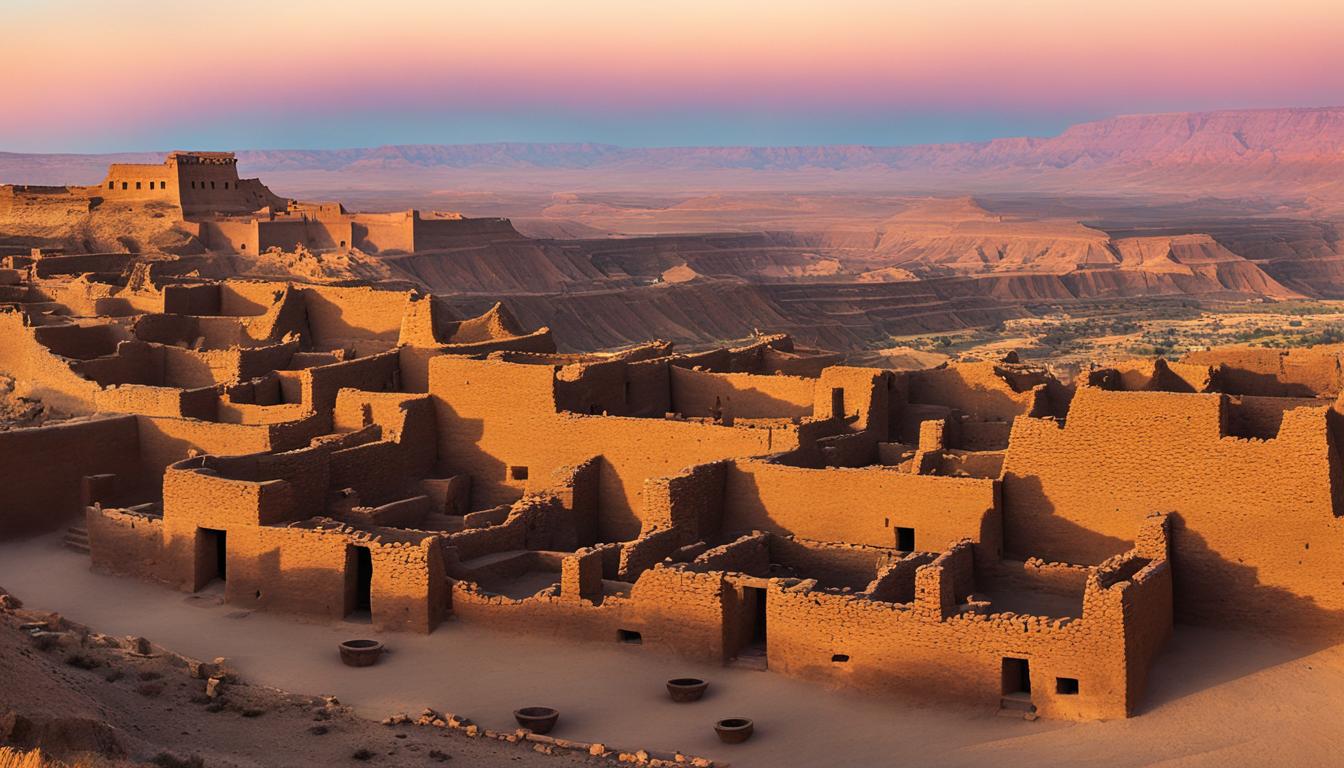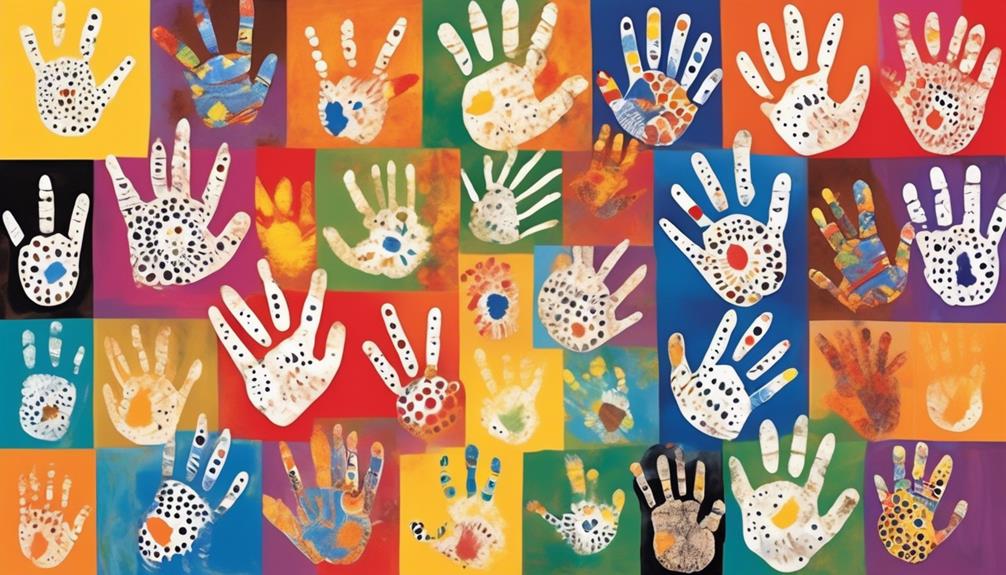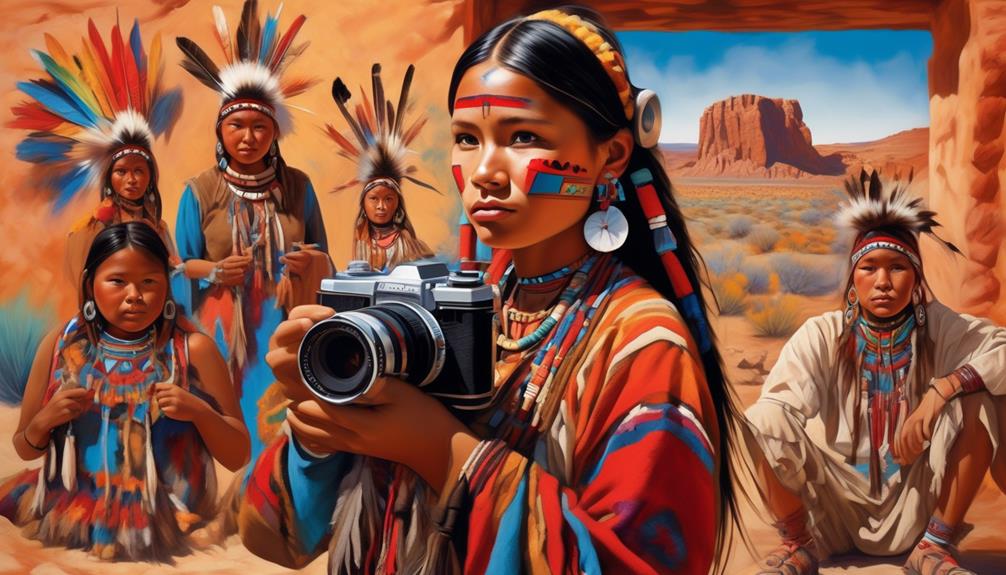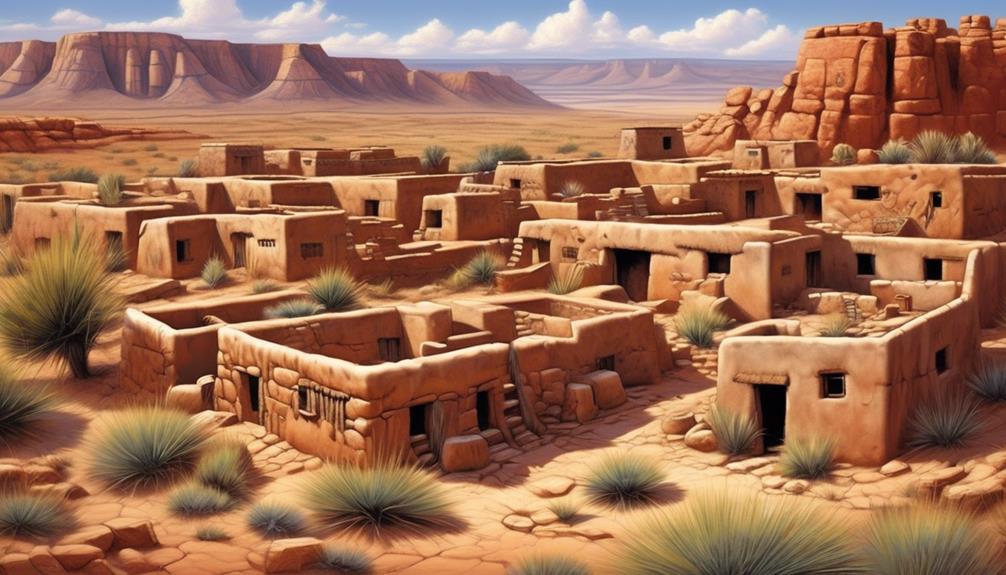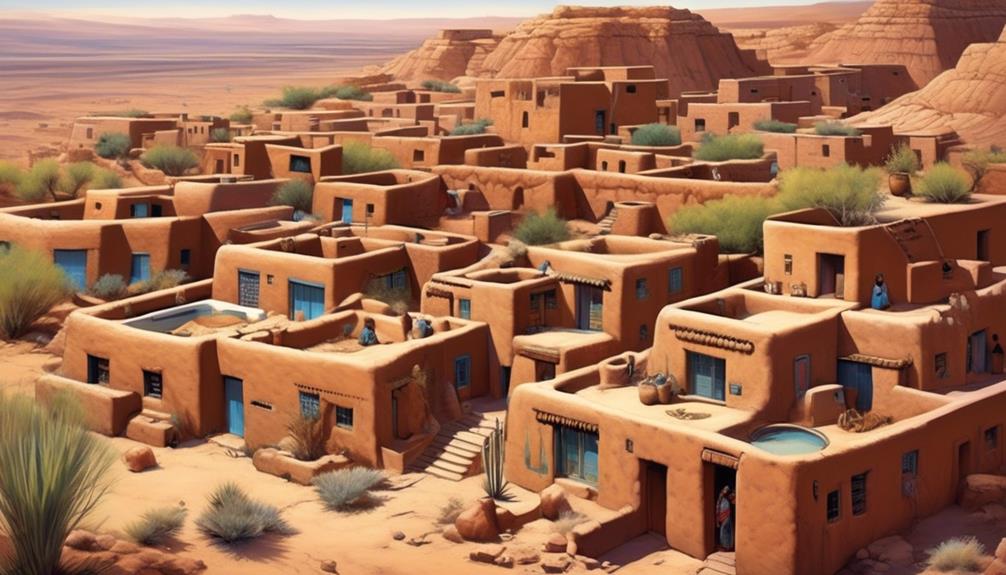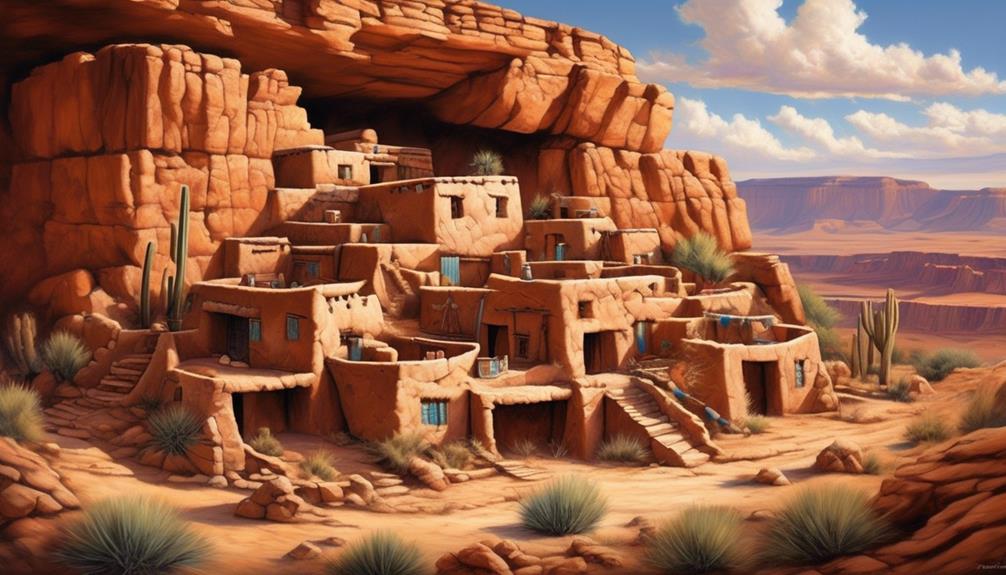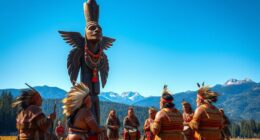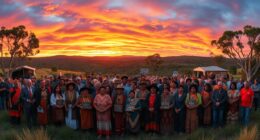Welcome to our exploration guide of the historic Hopi tribe settlements. Located amidst the stunning vistas of the Hopi reservation, these settlements provide an insight into the profound heritage and lively culture of the Hopi Indian Tribe. From the age-old pueblo settlements situated atop the mesas to the intriguing traditions and mesmerizing art, there’s a wealth of enchantment to uncover in this beautiful region of the United States.
The Hopi Tribe, located within the Navajo Nation, is made up of a dozen villages spread across three mesas – First Mesa, Second Mesa, and Third Mesa. For over 2,000 years, the Hopi people have cultivated their unique way of life, preserving their culture, language, and religion. As you explore these ancient villages, you’ll witness the deep connection to the land through their agricultural practices and experience a culture steeped in rich traditions.
Visiting the Hopi villages is an opportunity to immerse yourself in the fascinating world of the Hopi Tribe. From guided tours to local cultural centers, you’ll have the chance to learn about their history, traditions, and crafts. Connect with the locals and gain insights into their daily lives, beliefs, and artistic expressions that have been passed down through generations.
Key Takeaways:
- Explore the ancient Hopi tribe villages within the Navajo Nation.
- Discover the Hopi people’s agricultural practices, artistry, and deep-rooted cultural traditions.
- Visit the villages through guided tours and learn about the history and crafts of the Hopi Tribe.
- Immerse yourself in the vibrant Hopi culture and connect with the locals.
- Witness the breathtaking landscapes and stunning views from the mesas.
The History and Culture of the Hopi Tribe
The Hopi Tribe has a rich and fascinating history that spans thousands of years. These ancient caretakers of the earth have inhabited the Arizona region for over 2,000 years, making them one of the oldest Native American tribes in North America. The Hopi people have exhibited remarkable resilience in preserving their culture, languages, and religion throughout the centuries.
The Hopi tribe is renowned for its agricultural practices, which have sustained their communities for generations. The Hopi utilize traditional farming techniques, such as dry farming and irrigation systems, to cultivate crops like corn, beans, and squash. Their deep connection to the land and their sustainable farming methods showcase their commitment to environmental stewardship.
| Ancient Hopi Tribe | Hopi Traditions | Hopi Religion | Hopi Language |
|---|---|---|---|
| The Hopi tribe’s history dates back over 2,000 years. | Hopi traditions encompass various aspects of daily life, including ceremonies, dances, and artwork. | Hopi religion is a complex and intricate spiritual belief system that honors the natural world and ancestral spirits. | Hopi language, a unique form of Uto-Aztecan, is still spoken by tribal members today. |
The Hopi people have a deep-rooted connection to their ancestral lands, with each village situated on one of the three mesas – First Mesa, Second Mesa, or Third Mesa. These mesas not only provide a physical home for the Hopi, but they also serve as a symbolic representation of their spiritual beliefs and cultural identity.
The Hopi people have long exemplified a commitment to preserving their cultural heritage. This dedication has allowed them to maintain their traditional way of life and remain spiritually connected to their ancestors.
The artistry of the Hopi tribe is renowned worldwide. From intricate pottery and beautiful textiles to mesmerizing katsina carvings and basket weavings, their craftsmanship reflects the deep cultural significance of their creations. Through their art, the Hopi people express their history, values, and spiritual beliefs, providing a window into their unique cultural heritage.
Hopi Traditions: Ceremonies, Dances, and Spiritual Beliefs
Hopi traditions are deeply woven into the fabric of daily life. Ceremonies and dances play a vital role in Hopi culture, serving as a way to honor ancestral spirits, maintain balance in the universe, and seek blessings for the community. The Hopi Snake Dance, one of their most famous ceremonies, is performed biennially to ensure the renewal of life and fertility.
The Hopi religion centers around the belief in katsinas (also known as kachinas), spiritual beings that represent various aspects of the natural world. These sacred entities are believed to bring blessings and guidance to the Hopi people. During ceremonies and dances, individuals don intricately crafted katsina masks, evoking the presence and power of these spiritual beings.
Despite the challenges faced by the Hopi people throughout history, their commitment to preserving their history, traditions, and spiritual beliefs remains unwavering. Through their language, art, and ceremonies, they continue to pass down their ancestral wisdom to future generations, ensuring the preservation of their unique culture.
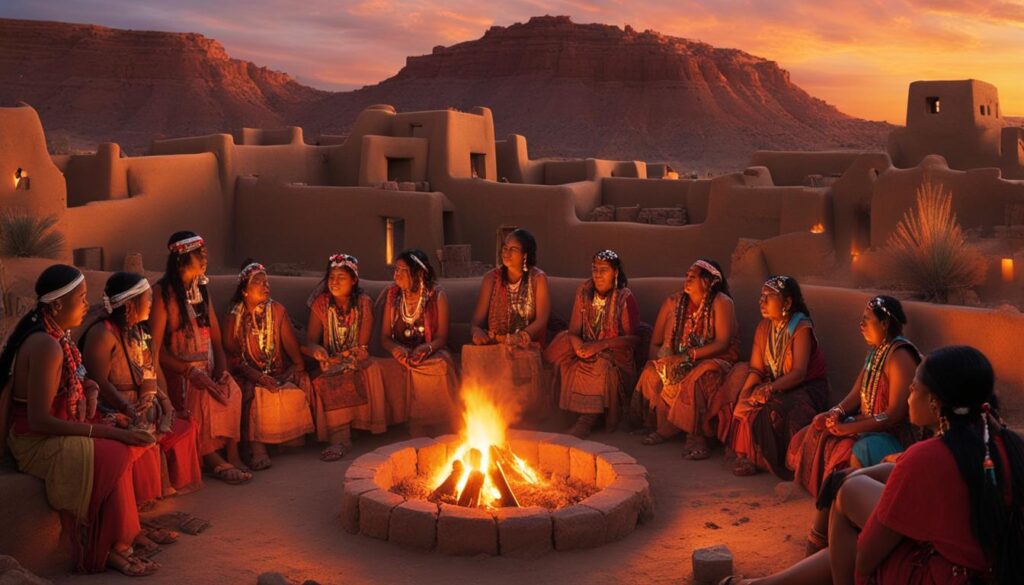
“Exploring the vibrant villages of Second Mesa allows us to delve into the rich traditions and remarkable artistry of the Hopi people. From the intricate silver jewelry of Shungopavi to the spiritual significance of the Snake Dance in Mishongnovi, and the historical resilience of Sipaulovi, each village holds a unique piece of Hopi culture that truly resonates with visitors.” – Hopi Cultural Center
Village Comparison
| Village | Year Founded | Specialties |
|---|---|---|
| Shungopavi | 1750 | Silver jewelry, coiled plaques |
| Mishongnovi | Named after the leader of a clan | Hosts the Snake Dance during odd-numbered years |
| Sipaulovi | Founded after the Pueblo Revolt of 1680 |
Experience the allure of Second Mesa and discover the rich cultural tapestry woven into the villages of Shungopavi, Mishongnovi, and Sipaulovi. Each unique village offers a glimpse into the time-honored traditions and craftsmanship of the Hopi people, ensuring an unforgettable journey of exploration and discovery.
Exploring Third Mesa Villages
As we venture further into the heart of the Hopi reservation, we reach the Third Mesa, which is home to a collection of captivating villages that provide a rich glimpse into the history and crafts of the Hopi people. Let’s explore these unique villages together.
Oraibi Village
Oraibi, dating back to 1150, holds the distinction of being the oldest continuously occupied town in the United States. Nestled on Third Mesa, Oraibi is a fascinating blend of old stone houses and modern structures. As we wander through Oraibi, we can immerse ourselves in the stories of the Hopi people, experiencing their culture and witnessing the traditional craftsmanship passed down through generations.
Hotevilla Village
Founded in 1906, Hotevilla stands out as the most conservative of the Hopi villages. Over the years, it has had frequent confrontations with the federal government, evident in the resilient spirit of its residents. Exploring Hotevilla provides a unique opportunity to understand the challenges and deep-rooted convictions that shape the identity of this remarkable village.
Kykotsmovi Village
Situated on Third Mesa, Kykotsmovi, also known as Lower Oraibi or New Oraibi, serves as the seat of the Hopi Tribal Government. This vibrant village showcases a blend of tradition and progress, offering us a chance to witness the governance and decision-making processes that are integral to the Hopi way of life. As we traverse Kykotsmovi, we discover the intricate tapestry of Hopi culture and its contemporary expressions.
Bacavi Village
Bacavi was founded in 1907 by Hopi villagers who sought to return to Oraibi but were not permitted to do so. Determined to maintain their strong connection to their ancestral lands, they established Bacavi as a new village. Today, Bacavi serves as a testament to the resilience and determination of the Hopi people, embodying their unwavering spirit and commitment to their heritage.
“With each step we take through the Third Mesa villages, we delve deeper into the rich tapestry of Hopi history, culture, and resilience.”
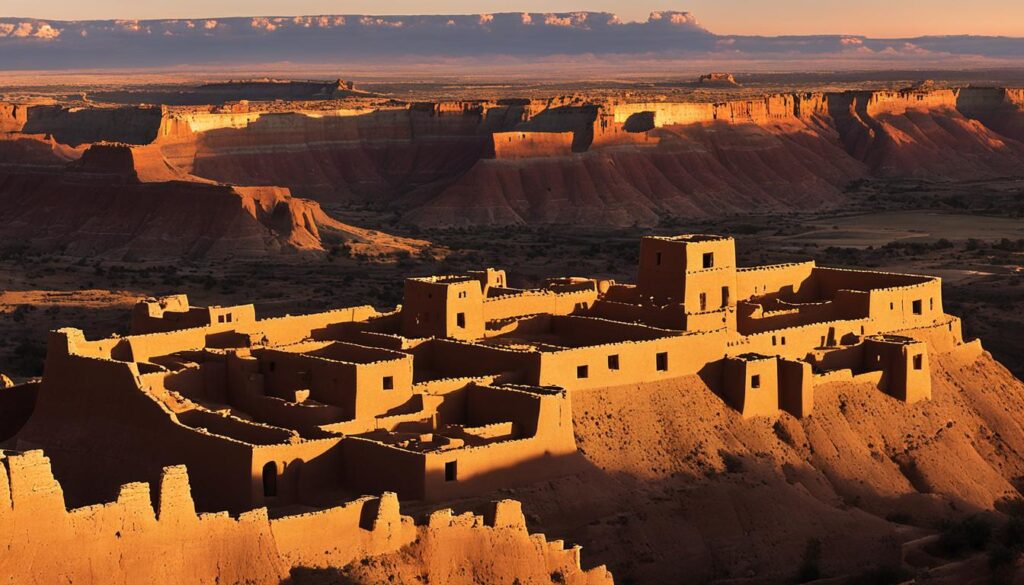
| Village | Established | Significance |
|---|---|---|
| Oraibi | 1150 | The oldest continuously occupied town in the United States. A mix of old stone houses and modern ones. |
| Hotevilla | 1906 | The most conservative Hopi village. Frequent confrontations with the federal government. |
| Kykotsmovi (Lower Oraibi or New Oraibi) | Unknown | Seat of the Hopi Tribal Government. Blend of tradition and progress. |
| Bacavi | 1907 | Founded by villagers seeking to return to Oraibi. A testament to resilience and determination. |
Experiencing Hopi Arts and Crafts
The Hopi villages are a treasure trove of artistic expressions, showcasing the rich heritage and creativity of the Hopi people. Each mesa village specializes in unique arts and crafts, allowing visitors to immerse themselves in the beauty and craftsmanship of Hopi traditions.
First Mesa: Handmade Hopi Pottery and Artistic Paintings
First Mesa is renowned for its exquisite handmade Hopi pottery, which reflects the mastery and skill of Hopi artists. The pottery features intricate designs and vibrant colors that tell stories of the Hopi culture and traditions. Visitors can admire the artistry and even purchase one-of-a-kind pieces to take home as a cherished memento.
Second and Third Mesas: Traditional Hopi Textiles and Weavings
The Second and Third Mesas are known for their exceptional textiles and weavings, which are an integral part of Hopi culture. Skilled weavers create beautiful blankets, rugs, and garments using traditional techniques passed down through generations. These textiles often feature intricate patterns and symbolic designs that hold deep cultural significance.
Wicker, coil plaques, and multicolored yucca baskets are also unique crafts found in these villages, showcasing the ingenuity and creativity of the Hopi people. These handcrafted items are not only visually stunning but also carry the stories and traditions of the Hopi culture.
Hopi Arts Trail: A Journey Through Hopi Tribal Lands
For art enthusiasts and cultural explorers, following the Hopi Arts Trail is a remarkable experience. The trail leads visitors to various galleries situated in the villages across Hopi tribal lands. Here, visitors can witness artists in action, observe their techniques, and appreciate the incredible talent behind each masterpiece.
In the words of the Hopi artists themselves, “Our arts and crafts are not just objects; they are the embodiment of our spirituality, beliefs, and connection to the earth.”
The Hopi Museum and Art Gallery
For a deeper understanding of Hopi arts and crafts, a visit to the Hopi Museum and Art Gallery is highly recommended. Located in one of the Hopi villages, this cultural institution houses a vast collection of artifacts, pottery, paintings, and traditional crafts. It offers a unique opportunity to delve into the historical context and significance of Hopi art forms.
Through the Hopi arts and crafts, the Hopi people beautifully express their rich cultural heritage and spiritual connection to the world around them. The intricate designs and techniques passed down through generations are a testament to their creativity, resilience, and reverence for their traditions. Exploring the Hopi villages and engaging with their arts and crafts is a truly enriching experience that allows visitors to appreciate the beauty and depth of Hopi culture.
Experiencing Hopi Ceremonial Dances
The Hopi Tribe is renowned for its rich cultural heritage, which is beautifully showcased through their ceremonial dances. While many of these dances are closed to the public, the Hopi people do offer social dances that provide a captivating glimpse into their cherished traditions and spirituality. These vibrant social dances, often performed in village plazas or streets, offer visitors a unique opportunity to immerse themselves in the captivating world of Hopi culture.
One of the most famous ceremonial dances performed by the Hopi Tribe is the Snake Dance. This sacred dance takes place during the late summer months of August and is a powerful manifestation of the Hopi people’s enduring connection with nature. The Snake Dance represents the Hopis’ prayers for rain and the protection of their crops. It is a majestic spectacle that combines rhythmic movements, elaborate costumes, and the presence of live snakes, all symbolizing the spiritual harmony between the Hopis and the natural world.
Throughout the year, the Hopi people also engage in a variety of other social dances that celebrate different aspects of their culture and history. These social dances are an expression of communal unity and are performed to honor deities, seasonal changes, and other significant events. The dances showcase the Hopi people’s exceptional artistry and devotion to their spiritual beliefs, creating a captivating experience for those fortunate enough to witness them.
Visitors to the Hopi villages can witness these social dances, which are usually open to the public. The dances take place during specific periods, and it is essential to check the schedule in advance. The performances often occur in the village plazas or along the streets, where visitors can marvel at the authentic costumes, mesmerizing movements, and synchronized rhythms of the Hopi dancers.
Hopi Social Dances
| Dance | Significance |
|---|---|
| Butterfly Dance | Celebrates the arrival of butterflies and the pollination of crops. |
| Harvest Dance | Commemorates the bountiful harvest and expresses gratitude to the earth. |
| Kachina Dances | Honors the kachina spirits and seeks their blessings for various purposes. |
| Hopi-Tewa Women’s Dance | Portrays the essential role of women in Hopi society and celebrates feminine strength and resilience. |
Experiencing Hopi ceremonial dances is a profound way to connect with the vibrant spirit of Hopi culture. These dances reflect the Hopi people’s unwavering dedication to their traditions, artistry, spirituality, and deep connection with the natural world. Witnessing these vibrant dances allows visitors to gain a deeper appreciation for the rich heritage and thriving cultural legacy of the Hopi Tribe.
Planning Your Visit to Hopi Villages
Visiting the Hopi villages requires planning and preparation. If you are interested in exploring the rich culture and history of the Hopi Tribe, there are a few key things to keep in mind.
While Walpi on First Mesa is the only village that offers organized tours, there are independent tour guides certified by the tribe who can be hired to take you to other villages. These knowledgeable guides will provide you with valuable insights and ensure an immersive experience.
The Hopi Cultural Center, located on Second Mesa, is an excellent resource for information and guidance. They can assist you in planning your visit and offer guided tours to enhance your understanding and appreciation of the Hopi culture.
To make the most of your trip, it is advisable to contact the Hopi Tribe or the Hopi Cultural Center ahead of time. Inquire about visiting hours, entrance fees, and tour availability to ensure a smooth and enjoyable visit to the Hopi villages.
Immerse yourself in the rich history and vibrant culture of the Hopi people through guided tours and the expertise of certified tour guides. Don’t miss the opportunity to visit the Hopi Cultural Center for valuable insights and unforgettable experiences.
Hopi Village Tour Options
| Village | Tour Options |
|---|---|
| Walpi (First Mesa) | Organized tours available |
| Other Villages | Independent tour guides certified by the Hopi Tribe |
| Hopi Cultural Center (Second Mesa) | Guided tours and information services |
“Visiting the Hopi villages offers a unique opportunity to immerse yourself in the rich culture and history of the Hopi Tribe. With proper planning and the guidance of certified tour guides, you can have an unforgettable and educational experience.” – Hopi Cultural Center
Exploring the Surrounding Area
While visiting the Hopi reservation, there are many nearby attractions to explore. Northern Arizona is home to stunning landscapes and iconic sites that showcase the natural beauty of the region. Some of the must-visit attractions near the Hopi mesas include:
Oak Creek Canyon
Experience the breathtaking beauty of Oak Creek Canyon, known for its vibrant autumn colors, towering red rock formations, and crystal-clear waters. This scenic gorge offers hiking trails, picnic spots, and opportunities for fishing and swimming.
The Tallest Peak in Arizona: Humphreys Peak
Challenge yourself with a hike to the summit of Humphreys Peak, located within the San Francisco Peaks. Standing at 12,633 feet, it is the highest point in Arizona and offers panoramic views of the surrounding countryside. Nature enthusiasts can marvel at the diverse flora and fauna found on this challenging trail.
Antelope Canyon
Discover the ethereal beauty of Antelope Canyon, a slot canyon famous for its mesmerizing light beams and sculpted sandstone walls. Take a guided tour to capture stunning photographs and learn about the geological and cultural significance of this natural wonder.
Canyon de Chelly
Explore the rich history and cultural heritage of the Navajo Nation at Canyon de Chelly National Monument. Marvel at the towering sandstone cliffs, ancient cliff dwellings, and intricate rock formations. Embark on a guided tour to learn about the Navajo people’s ancestral connections to this sacred place.
“The surrounding area near the Hopi reservation offers a diverse range of natural wonders and cultural experiences, providing visitors with a well-rounded exploration of this unique region.”
To make the most of your trip, consider staying at the Moenkopi Legacy Inn & Suites near Tuba City. This conveniently located hotel provides easy access to the nearby attractions and offers the convenience of booking approved guides and tours on-site.
| Attraction | Description |
|---|---|
| Oak Creek Canyon | A scenic gorge known for its vibrant autumn colors, towering red rock formations, and crystal-clear waters. Offers hiking trails, picnic spots, and opportunities for outdoor activities. |
| Humphreys Peak | The highest point in Arizona, offering panoramic views of the surrounding countryside. A challenging hike that rewards nature enthusiasts with diverse flora and fauna. |
| Antelope Canyon | A mesmerizing slot canyon renowned for its unique rock formations and stunning light beams. Take a guided tour to capture breathtaking photographs. |
| Canyon de Chelly | A sacred place with towering sandstone cliffs, ancient cliff dwellings, and a rich cultural heritage. Explore the history and ancestral connections of the Navajo Nation through guided tours. |
Getting to Hopi Villages
When planning your visit to the Hopi villages, it’s important to consider transportation options and access to the reservation. Here is some helpful information to assist you in getting to the Hopi villages.
Guided Tour or Certified Tour Guide
Access to the Hopi villages is possible through guided tours or hiring a certified tour guide. These options provide a structured and informative experience, allowing you to learn about the rich history and culture of the Hopi people. Tour companies can arrange transportation to the villages, ensuring a hassle-free journey.
Driving to Designated Areas
If you prefer a more independent approach, you can drive to designated areas and meet your tour guide there. This option gives you the flexibility to explore the area at your own pace while still benefiting from the knowledge and expertise of a certified guide.
Respecting Hopi Tribe’s Rules and Regulations
It’s crucial to respect the rules and regulations set by the Hopi Tribe when accessing their lands. Many areas within the reservation are restricted, and it’s important to abide by these guidelines to ensure the preservation of their cultural heritage and environment.
Advance Planning
To have a smooth and enjoyable visit to the Hopi villages, it’s recommended to plan your transportation and logistics in advance. This includes booking guided tours or hiring certified tour guides well ahead of your visit. By doing so, you can secure your spot and have a stress-free experience.
By considering these factors and making the necessary arrangements, you can embark on a memorable journey to the enchanting Hopi villages. Whether you choose a guided tour or opt for a certified tour guide, you’ll have the opportunity to immerse yourself in the fascinating history, culture, and traditions of the Hopi people.
Authentic Hopi Experience
Visiting the Hopi villages offers an authentic and immersive experience of the Hopi culture. Through guided tours, visitors can learn about the history, traditions, and spirituality of the Hopi people from knowledgeable guides.
At the Hopi Cultural Center, you can explore the rich history and artistry of the Hopi Tribe. The center provides a glimpse into the vibrant culture and showcases traditional Hopi crafts, artwork, and artifacts.
As you explore the villages, don’t miss the opportunity to sample traditional Hopi food, a culinary experience that reflects the tribe’s agricultural practices and culinary traditions.
Another way to connect with the culture and traditions of the Hopi people is by visiting the Hopi Museum and Art Gallery. Here, you can admire a collection of exquisite Hopi artwork, including pottery, textiles, jewelry, and paintings.
Immerse yourself in the rich tapestry of the Hopi culture during your visit to the villages. Engage with the local community, listen to their stories, and witness their traditional dances and ceremonies. This authentic Hopi experience will leave you with a deep appreciation for their heritage and a lasting impression of this vibrant Native American tribe.
The Spirit of the Hopi Katsinas
Katsinas, also known as kachinas, hold a significant place in Hopi spirituality and culture. These extraordinary beings embody different aspects of the natural world, ancestors, and sacred sites. With over 300 katsinas, the Hopi believe their presence brings blessings and maintains harmony within the universe. Dancers wearing intricately crafted masks depicting katsinas perform ceremonial dances, which are an integral component of Hopi religious practices.
The kachina season spans from the winter solstice to shortly after the summer solstice, aligning with the agricultural rhythm of the Hopi people. During this time, various kachina dances take place, captivating both participants and spectators. These dances serve as a means of honoring the katsinas, seeking their guidance, and celebrating their spiritual connection to the natural world.
The Hopi ceremonial masks, representing specific katsinas, are handmade by skilled craftsmen within the tribe. These masks are not only exquisite pieces of art but also hold deep cultural and spiritual significance. Each mask is meticulously crafted using traditional techniques and materials such as wood, feathers, and natural pigments.
“The katsinas are not just symbols or performances; they are the essence of our spiritual beliefs and guides in maintaining harmony with nature and the divine.”
Through their dances and masks, the Hopi people reinforce their deep reverence for the natural world and their connection to the spiritual realm. The katsinas represent a bridge between the physical and the spiritual, guiding the Hopi in their pursuit of a balanced and meaningful existence.
Hopi Katsinas and their Meanings
Each katsina holds its unique symbolism, representing various natural elements or ancestral spirits. Here are a few prominent katsinas and their meanings:
- Kwahu: Represents the sacred eagle and symbolizes strength, vision, and protection.
- Angak’china: Personifies the storyteller and teaches moral lessons through stories and legends.
- Hemis Katsina: Associated with agricultural fertility, abundance, and the arrival of summer rains.
- Tsuku: Depicts the horned owl and embodies wisdom, night vision, and protection against evil spirits.
These are just a few examples, as the Hopi have an extensive pantheon of katsinas, each playing a crucial role in Hopi ceremonial life.
“The artistry and spiritual essence of Hopi ceremonial masks are a testament to the deep-rooted and vibrant culture of the Hopi people.”
Conclusion
Exploring the ancient Hopi tribe villages is a remarkable journey into the rich history, vibrant culture, and enduring traditions of the Hopi people. Nestled on the breathtaking mesas of the Hopi Reservation, these villages offer a captivating window into one of the oldest Native American tribes in North America.
From the moment you set foot on the mesas, you are greeted with awe-inspiring views that showcase the natural beauty of the Hopi homeland. As you delve deeper into the villages, you will discover the intricate artistry and craftsmanship that has been passed down through generations, from mesmerizing Hopi pottery to stunning jewelry and textiles that reflect their deep connection to the land.
To fully immerse yourself in the Hopi culture, it is important to respect the Hopi Tribe’s rules and regulations when visiting the villages. Engaging in guided tours or hiring certified tour guides not only ensures a smooth and enriching experience but also contributes to the preservation of the Hopi way of life.
As you explore the enchanting Hopi tribe villages, be prepared to be captivated by the stories and traditions that have shaped the Hopi people for thousands of years. Whether you witness the mesmerizing ceremonial dances, learn about the spiritual significance of the Hopi katsinas, or simply soak in the peacefulness of this ancient land, your visit to the Hopi Reservation will leave you with a profound appreciation for the resilience and cultural heritage of the Hopi Indian Tribe.
FAQ
Where are the Hopi Tribe villages located?
The Hopi Tribe villages are located within the Navajo Nation in Arizona.
How many villages are there in the Hopi Tribe?
The Hopi Tribe is made up of a dozen villages across three mesas – First Mesa, Second Mesa, and Third Mesa.
What is the history of the Hopi Tribe?
The Hopi Tribe has a history spanning over 2,000 years, with their presence in the Arizona region going back thousands of years.
What are the Hopi Tribe known for?
The Hopi Tribe is known for their agricultural practices, artistry, and preservation of their culture, language, and religion.
Can I visit the Hopi villages?
Yes, visiting the Hopi villages is possible through guided tours, with Walpi on First Mesa being the only village that offers organized tours.
Where can I start my visit to the Hopi villages?
The Hopi Cultural Center, located on Second Mesa, is a great starting point for visitors. It offers a gallery, restaurant, and inn and provides insights into the rich history and culture of the Hopi people.
What villages are on First Mesa?
First Mesa is home to several Hopi villages, including Walpi, Sichomovi, Hano, and Polacca.
What can I find on Second Mesa?
Second Mesa is the center of tourism in Hopiland. The villages on Second Mesa include Shungopavi, Mishongnovi, and Sipaulovi.
What is the oldest town in the United States on Third Mesa?
Oraibi, located on Third Mesa, is the oldest continuously occupied town in the United States, dating back to 1150.
What arts and crafts are the Hopi Tribe known for?
The Hopi villages are renowned for their arts and crafts, including pottery, jewelry, textiles, weavings, and more.
What ceremonial dances do the Hopi Tribe perform?
The Hopi Tribe performs ceremonial dances, including the famous Snake Dance, which is closed to the public. Social dances, however, are usually open and provide a glimpse into the culture and traditions of the Hopi people.
How can I visit the Hopi villages?
Visiting the Hopi villages requires planning and preparation. Walpi on First Mesa is the only village that offers organized tours. Independent tour guides certified by the tribe can also be hired to visit other villages.
What attractions are near the Hopi reservation?
There are many nearby attractions to explore, including Oak Creek Canyon, the tallest peak in Arizona, Antelope Canyon, and Canyon de Chelly.
How can I get to the Hopi villages?
Access to the Hopi villages is possible by guided tour or hiring a certified tour guide. It is essential to respect the Hopi Tribe’s rules and regulations when accessing their lands, as many areas are restricted.
What can I expect from an authentic Hopi experience?
Visiting the Hopi villages offers an authentic and immersive experience of the Hopi culture, with guided tours, traditional food sampling, and a chance to explore the Hopi Museum and Art Gallery.
What are katsinas in Hopi culture?
Katsinas, also known as kachinas, are spiritual beings that represent various aspects of the natural world, ancestors, and sacred places in Hopi culture.
